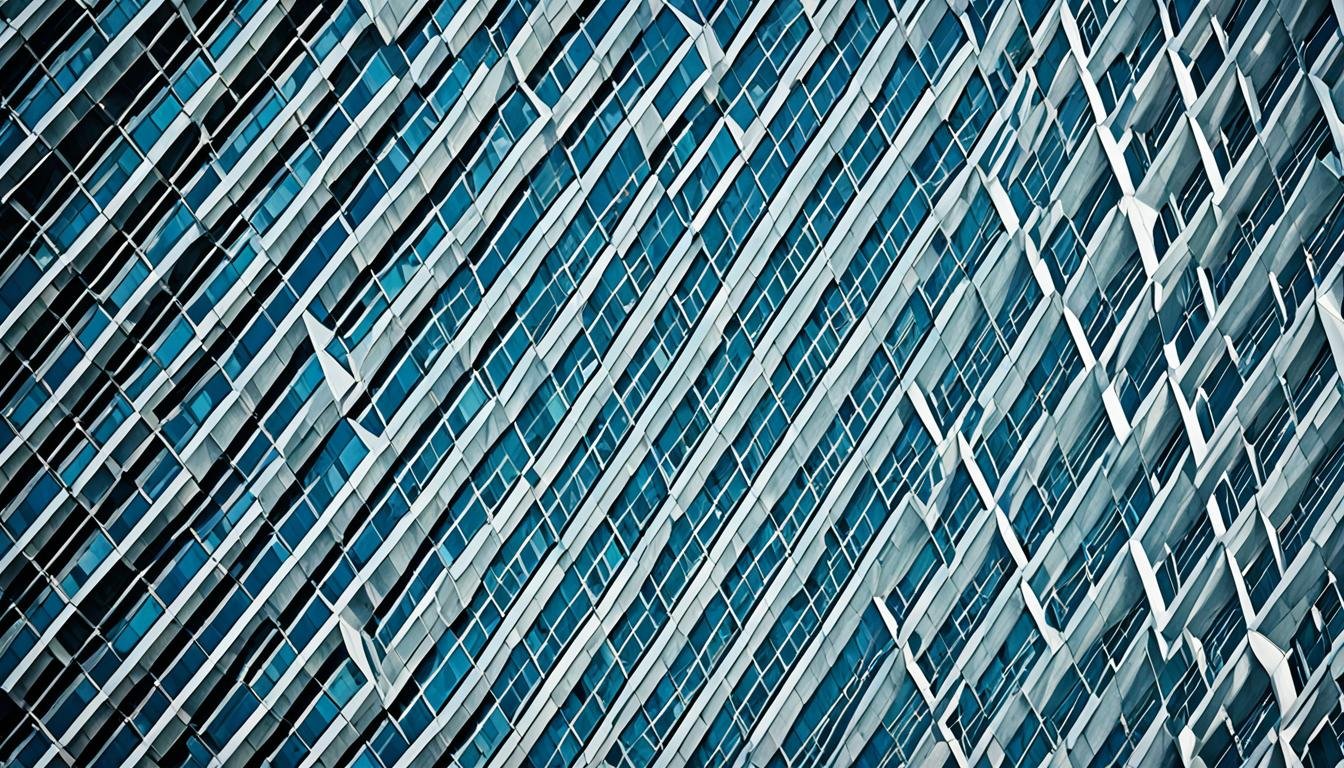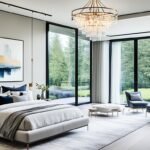Architectural photography is a fascinating genre that encompasses the essence and design of buildings through the skillful technique and creative vision of a photographer. It goes beyond capturing mere structures, instead highlighting the intricate details, unique perspectives, and artistic elements that make each architectural work a masterpiece.
The art of architectural photography requires a keen eye for design, composition, and lighting. It involves understanding the client’s vision, needs, and expectations to effectively showcase the photographer’s skill and creativity in representing the architectural space.
Through careful consideration of angles, perspective, lighting techniques, and post-processing, architectural photographers create images that capture the imagination and tell a compelling visual story of the built environment.
Key Takeaways:
- Architectural photography is a unique genre that aims to capture the essence and design of buildings.
- It requires skillful technique, creative vision, and an understanding of the client’s vision and expectations.
- Lighting, composition, and perspective play crucial roles in creating impactful architectural photographs.
- Post-processing techniques can enhance the final images while maintaining a sense of realism and authenticity.
- Architectural photography allows photographers to showcase their unique style and storytelling abilities.
Know Your Audience – Tailoring Your Approach in Architectural Photography
When it comes to architectural photography, understanding your audience is essential for delivering compelling and impactful images. Before embarking on a photography project, take the time to research and delve into the goals, preferences, and styles of your target market.
In the realm of architectural photography, your target market typically consists of architects, developers, interior designers, and real estate agents. Each of these professionals has unique needs and tastes when it comes to showcasing their work or properties. By knowing your audience, you can tailor your approach, angle, and editing to suit their specific requirements.
Architects, for instance, are highly focused on highlighting the design elements and functionality of a building. They often appreciate bold angles and compositions that emphasize the architectural features. Developers, on the other hand, might prioritize capturing both the interior and exterior of a property, conveying its potential to potential buyers or investors. Interior designers tend to seek images that showcase their stylistic choices and attention to detail in creating visually stunning spaces. Real estate agents typically seek images that emphasize curb appeal and highlight the unique selling points of a property.
Knowing your audience enables you to create images that resonate with them and effectively meet their objectives. By aligning your artistic vision with their expectations, you can establish lasting professional relationships and build a strong reputation in the architectural photography industry.
Connecting Through Visual Storytelling
Architectural photography is not solely about capturing buildings; it’s about telling a visual story. By understanding your audience, you can select subjects and compositions that convey the purpose, function, and emotion of the architecture in a way that resonates with their target audience.
For example, if you’re photographing a luxury hotel for a developer, your approach might emphasize the opulence and elegance of the interiors. On the other hand, if your target audience is an architectural magazine, you may focus on capturing unique angles and details that showcase the innovative design and craftsmanship. By tailoring your approach to the audience, you can create images that effectively communicate the intended message.
Delivering Images That Appeal to the Senses
In addition to knowing your audience’s professional preferences, it’s important to consider their aesthetic tastes. Some clients might prefer images that emphasize the play of light and shadow, while others may lean towards a bright and airy aesthetic. Understanding these preferences allows you to capture and edit images that align with their personal style.
Interior designers often appreciate images with warm, inviting tones that evoke a sense of coziness and comfort. Real estate agents, on the other hand, may prefer images that are bright, crisp, and spacious, allowing potential buyers to envision themselves in the property. By tailoring your editing techniques to suit the preferences of your audience, you can create images that elicit an emotional response and resonate with their desired aesthetic.
Adapting to Your Target Market’s Platform
Another crucial aspect of knowing your target audience is understanding the platforms they utilize to showcase their work or market their properties. Some architects and interior designers may prefer images that are suited for print publication, while others may primarily use online platforms or social media to promote their projects. Real estate agents often require images that are optimized for online listings or virtual tours.
By tailoring your approach and delivering images that are compatible with the chosen platform, you can ensure maximum impact and engagement. Understanding the technical requirements, resolution, and composition guidelines for each platform helps you produce images that are ready for immediate use and visually stunning on any device or medium.
Choosing the Right Time and Lighting in Architectural Photography
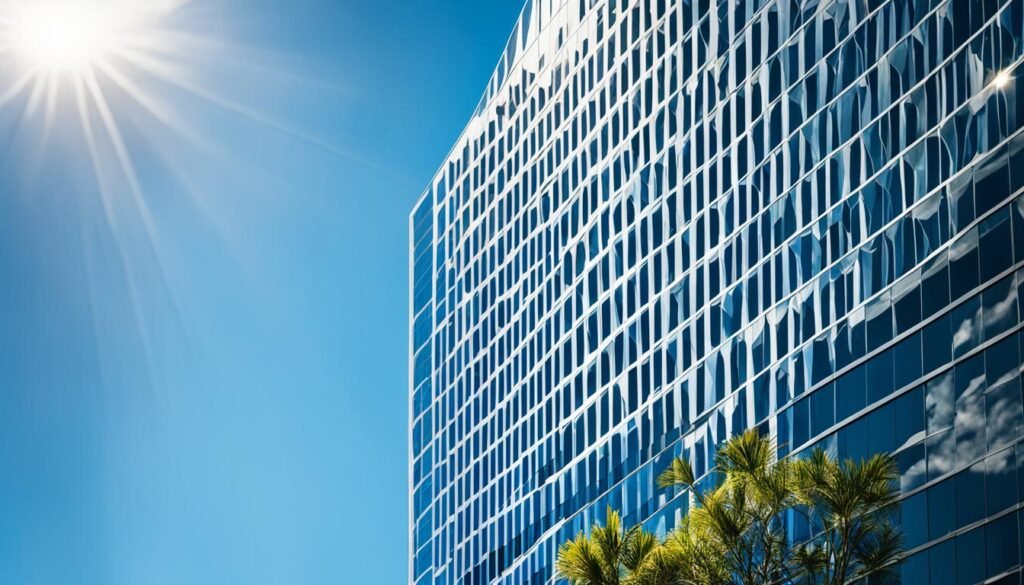
The quality and direction of light play a crucial role in architectural photography. Capturing the perfect shot requires careful consideration of lighting techniques and timing. By understanding how different lighting conditions can enhance a building’s visual impact, photographers can create stunning images that showcase the architecture in its best light.
The Golden Hour and Blue Hour
One of the most sought-after lighting opportunities in architectural photography is the golden hour. This is the period shortly after sunrise or before sunset when the sun is low in the sky, creating a warm, golden glow. The soft, directional light during this time of day adds depth and dimension to the building’s features, casting long and dramatic shadows.
Similarly, the blue hour refers to the time before sunrise or after sunset when the sky takes on a beautiful blue hue. This ethereal light can create a serene and tranquil ambiance, especially when combined with the subtle illumination of artificial lights within the building. It offers a unique opportunity to capture the architectural details against a captivating backdrop of twilit colors.
Artificial Lighting Techniques
While natural light is often preferred in architectural photography, artificial lighting can be used to accentuate specific features or create striking contrasts. Photographers may employ techniques such as spotlighting to draw attention to a particular architectural element or utilize ambient lighting to enhance the overall atmosphere of the space.
Experimenting with different combinations of natural and artificial lighting allows photographers to achieve the desired mood and emphasize the architectural design. It is essential to strike a balance to ensure the lighting enhances the subject without overwhelming the composition or detracting from the building’s form and structure.
| Lighting Techniques | Description |
|---|---|
| Spotlighting | Directing a focused beam of light to highlight a specific architectural element, drawing attention to its details and creating a focal point within the composition. |
| Ambient Lighting | Using a soft, diffused light source, such as strategically placed lamps or LEDs, to create a warm and inviting atmosphere that complements the building’s design and purpose. |
| Contrast Lighting | Using a combination of light and shadow to create visual interest and emphasize the textures and forms of the architecture, adding depth and dimension to the photograph. |
By understanding the different lighting techniques and choosing the right time to shoot, photographers can capture the essence and beauty of the architectural subject. Whether harnessing the golden hour’s warm glow, leveraging the ethereal colors of the blue hour, or utilizing artificial lighting, each approach offers a unique opportunity to create visually stunning images that showcase the architecture in its best light.
Using a Variety of Perspectives and Compositions in Architectural Photography
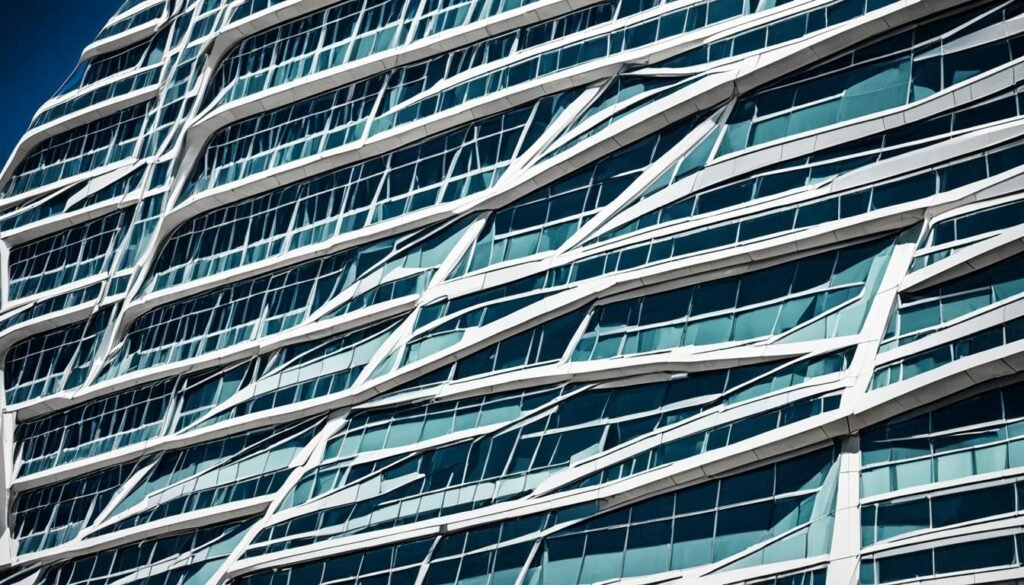
In architectural photography, capturing the essence and beauty of a building requires more than just a single shot of the entire structure. Photographers employ various perspectives and compositions to create images that are visually compelling and dynamic. By utilizing different techniques and equipment, they can showcase the character, scale, and context of the architecture.
Wide-Angle Lens and Telephoto Lens
One way photographers achieve captivating architectural shots is through the use of wide-angle lenses and telephoto lenses. Wide-angle lenses capture the grandeur of a building, emphasizing its scale and surrounding environment. These lenses are perfect for showcasing the entire structure in a single frame. On the other hand, telephoto lenses allow photographers to zoom in and focus on intricate details and textures, providing a closer look at the building’s unique features.
Drone and Tripod
To capture unique and innovative perspectives, photographers often employ drones and tripods. Drones offer an aerial view, delivering breathtaking images from above and providing a different vantage point. They allow photographers to explore the building’s surroundings and showcase the relationship between the architecture and the landscape. Tripods, on the other hand, provide stability and enable precise composition, ensuring sharp and well-aligned photographs.
Leading Lines, Symmetry, and Framing
Leading lines are powerful compositional elements used in architectural photography. They guide the viewer’s eye and create a sense of depth and dimension within the image. By incorporating elements such as corridors, pathways, or railings, photographers can lead the viewer’s gaze towards specific areas of the building. Symmetry is another technique that adds balance and harmony to architectural photographs. It highlights the building’s design and creates a pleasing visual aesthetic. Framing is yet another composition technique where photographers use elements in the foreground, such as doorways or windows, to frame the architecture and draw the viewer’s attention to the main subject.
Overall, architectural photography offers limitless opportunities for creativity and experimentation. By utilizing a variety of perspectives and compositions, photographers can capture the beauty and character of buildings from unique angles. Whether it’s through wide-angle lenses, telephoto lenses, drones, or tripods, the goal is to showcase the architectural marvels with impeccable composition, leading lines, symmetry, and framing techniques.
Paying Attention to Details and Post-Processing in Architectural Photography
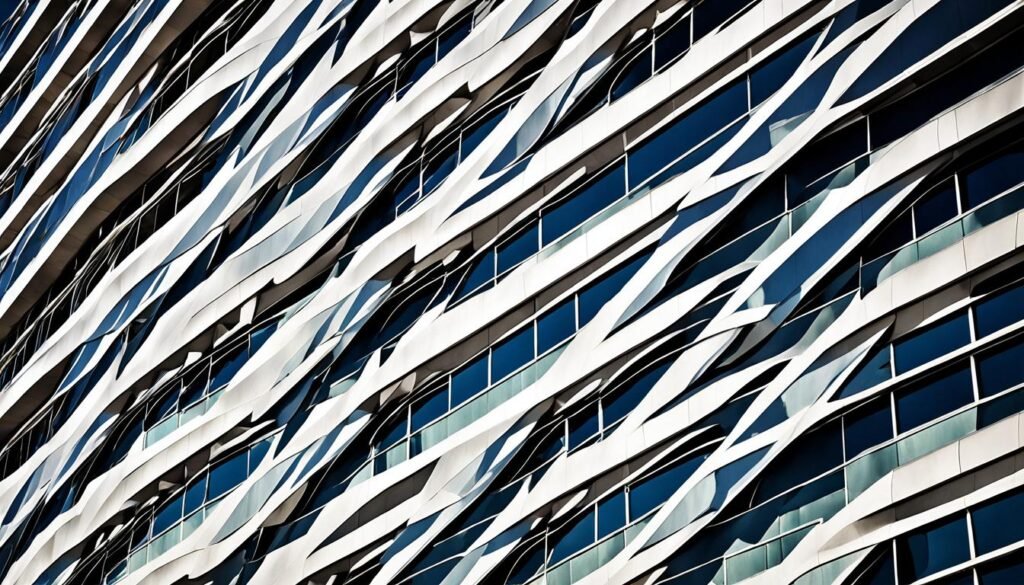
In architectural photography, the devil is in the details. Capturing sharp, clean, and accurate images is crucial to showcasing the true beauty and craftsmanship of architectural structures. To achieve this, photographers must pay careful attention to various aspects throughout the entire process, including focus, exposure, white balance, and alignment.
During the shoot, it is important to ensure that the subject is in focus, allowing the intricate architectural details to be captured with precision. Proper exposure ensures that all elements of the image are well-balanced, enhancing the overall visual impact. White balance is essential in capturing accurate colors, maintaining the integrity of the architecture’s design and materials. Alignment plays a crucial role in achieving straight vertical and horizontal lines, keeping the composition visually appealing and true to the architectural intent.
Post-processing is another crucial step in architectural photography. Tools like Photoshop and Lightroom provide photographers with the ability to refine and enhance their images, ensuring the final result is of the highest quality. During post-processing, adjustments can be made to correct distortion, reduce noise, and address any color-related issues. Additionally, contrast, saturation, and clarity can be enhanced to bring out the architectural features and emphasize the unique details of the structure.
However, it is important to strike a balance during post-processing. It is essential to maintain the realism and authenticity of the image, avoiding overprocessing that may result in an overly manipulated or unnatural appearance. The goal is to enhance the architectural details without compromising the integrity of the structure.
“The details are not the details. They make the design.” – Charles Eames
Table: Post-Processing Steps in Architectural Photography
| Post-Processing Step | Objective |
|---|---|
| Correct distortion | Ensure accurate representation of the architecture |
| Reduce noise | Enhance image clarity and quality |
| Adjust white balance | Preserve accurate colors and tones |
| Enhance contrast, saturation, and clarity | Showcase architectural details and features |
By paying meticulous attention to details during the shoot and employing thoughtful post-processing techniques, photographers can capture architectural images that not only highlight the beauty of the structure but also convey the true essence and vision of the architect.
Telling a Story and Showing Your Style in Architectural Photography
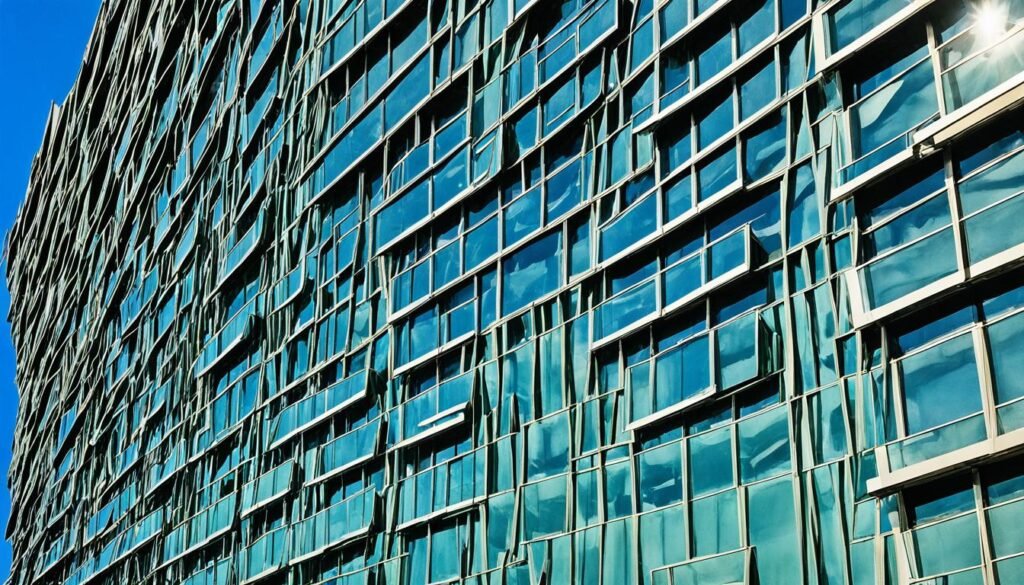
Architectural photography goes beyond mere documentation; it provides an opportunity to tell a story and showcase the photographer’s unique style. By incorporating human or natural elements into the composition, such as people, plants, or animals, photographers can add a sense of scale, life, and context to their images. These elements humanize the architecture, making it relatable and engaging for viewers.
Furthermore, architectural photography allows photographers to convey the purpose, function, and emotion of the architecture they capture. Each building has its own story to tell, and the photographer’s role is to capture its essence and convey it through images. Whether it’s the grandeur of a historical monument, the serene beauty of a residential retreat, or the cutting-edge design of a modern skyscraper, architectural photography has the power to evoke emotions and spark the viewer’s imagination.
In addition to capturing the architectural features, the photographer’s style plays an integral role in creating impact and uniqueness in their work. Each photographer has their own creative flair and signature style, which sets them apart from others in the field. It is through their style that photographers can inject their personality and vision into their images, making them instantly recognizable and memorable.
“Architectural photography is an art form that allows me to blend my passion for both architecture and photography. Through my work, I aim to capture not only the physical aspects of the buildings but also the emotions and stories they hold. I believe that by adding human elements and showcasing my own creative style, I can create images that resonate with viewers and truly bring the architecture to life.” – Jane Anderson, Architectural Photographer
Architectural photography is a means of creative expression, enabling photographers to convey their interpretation of the architecture they capture. It is a visual language that goes beyond words, allowing photographers to communicate their own vision and perspective. Through careful composition, attention to detail, and an understanding of light and form, photographers can craft images that leave a lasting impression on viewers.
When done effectively, architectural photography has the power to ignite curiosity, instill awe, and evoke a strong emotional response. It bridges the gap between the built environment and human experience, allowing viewers to appreciate and connect with architecture on a deeper level.
What Makes a Good Architectural Photo?
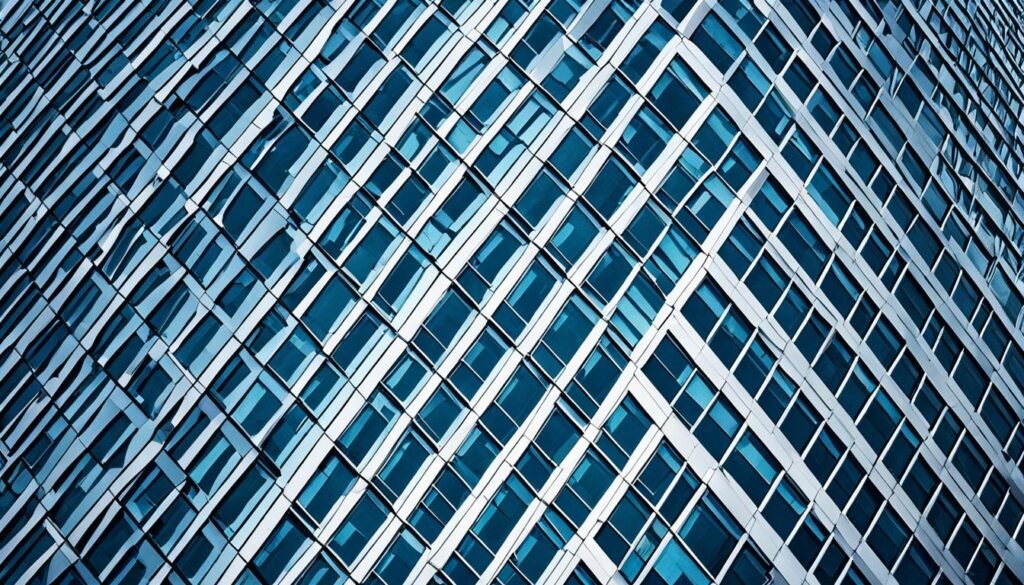
When it comes to architectural photography, capturing the essence and visual representation of the built environment is key. A good architectural photo goes beyond mere documentation; it creates a sense of perceived dimension and identity, drawing viewers into the space. This requires a combination of skills and techniques, honed through years of training, expertise, and innate talent.
One of the fundamental aspects of creating a good architectural photo is composition. Skillfully arranging the elements within the frame helps guide the viewer’s eye and highlights the unique features of the architecture. Whether it’s utilizing leading lines, playing with symmetry, or framing the shot in an innovative way, composition is crucial in creating a visually captivating image.
Lighting is another essential element in architectural photography. The right use of natural or artificial light can enhance the textures and details of the buildings, creating a sense of depth and dimension. Understanding how light interacts with different surfaces and materials is vital in accurately representing the architecture.
Attention to detail is paramount in capturing a good architectural photo. Every element, from the smallest intricate design to the overall structure, should be presented with precision and accuracy. The photographer’s ability to highlight these details is what truly distinguishes an exceptional architectural photograph.
Furthermore, techniques such as capturing the right perspective and utilizing the appropriate equipment can significantly impact the final result. Whether it’s using a wide-angle lens to showcase the grandeur of a building or employing a tilt-shift lens to correct perspective distortion, technical mastery plays a critical role in creating compelling architectural photographs.
In addition to technical skills, a good architectural photograph tells a story. It evokes emotions, conveys a sense of place, and captures the essence of the architecture. By showcasing the purpose, function, and human elements within the space, photographers can create a narrative that resonates with viewers.
“A good architectural photo is not just about the buildings; it captures the spirit of place and evokes a sense of awe and wonder.” – John Smith, Professional Architectural Photographer
Ultimately, a good architectural photo requires a combination of technical expertise, artistic vision, and the ability to skillfully blend various elements. It is a testament to the photographer’s mastery of composition, lighting, perspective, and attention to detail. Through their work, they create images that accurately represent the architecture and leave a lasting impact on viewers.
The Role of Lighting, Perspective, and Composition in Architectural Photography
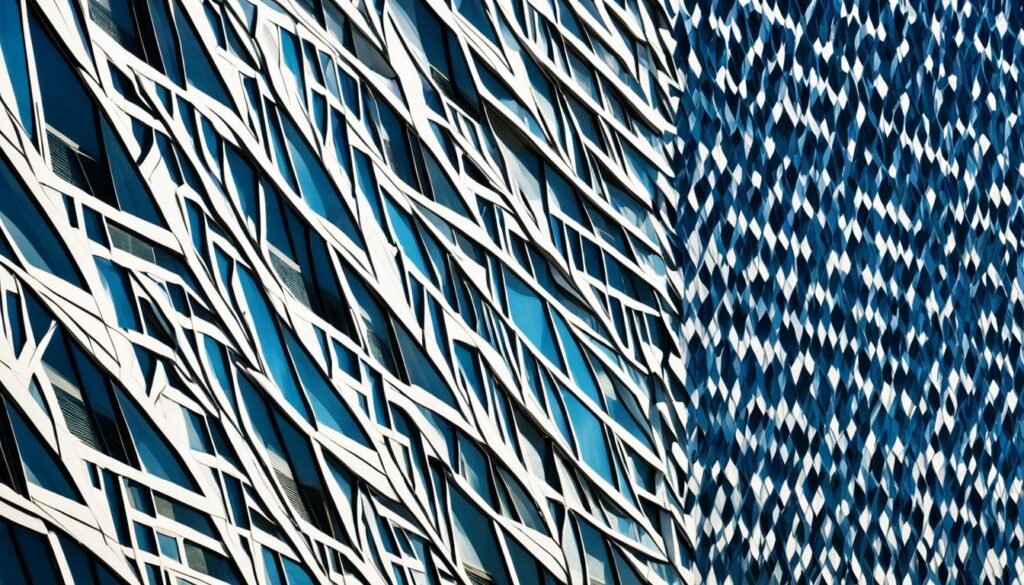
Lighting, perspective, and composition are fundamental elements in the art of architectural photography. These components come together to create visually captivating and impactful images that showcase the beauty and essence of architectural structures.
Lighting: Enhancing Features and Beauty
Good lighting is key in architectural photography as it helps enhance the features and beauty of the subject. By using natural or artificial light strategically, photographers can highlight architectural details, shape, and texture. The interplay of light and shadows adds depth and dimension to the photograph, emphasizing the unique design elements of the structure.
Perspective: Creating Depth, Scale, and Balance
Choosing the right perspective is crucial in architectural photography to convey a sense of depth, scale, and balance. Photographers carefully consider the angles and viewpoints to capture the building in its most flattering form. Straight vertical lines are often emphasized to showcase the height and grandeur of the structure, while converging lines can create a dynamic and compelling composition.
Composition: Adding Visual Appeal and Impact
Composition plays a significant role in architectural photography by adding visual appeal and impact. Photographers carefully consider the placement and arrangement of elements within the frame to create a balanced and harmonious composition. Choosing an interesting subject as the focal point can draw the viewer’s attention and create a captivating image. Additionally, the use of colors and tones contributes to the overall mood and atmosphere of the photograph, evoking different emotions and enhancing its visual impact.
By skillfully incorporating lighting, perspective, and composition, architectural photographers can create stunning images that convey a sense of scale, depth, and the unique character of the subject. Whether capturing the sleek lines of a modern skyscraper or the intricate details of a historic building, these elements work together to elevate the art of architectural photography.
| Elements | Description |
|---|---|
| Straight Vertical Lines | Emphasize the height and majesty of the structure |
| Interesting Subject | Add visual appeal and draw the viewer’s attention |
| Colors and Tones | Contribute to the overall mood and atmosphere of the image |
| Sense of Scale | Evoke a feeling of size and proportion within the frame |
| Depth | Create a three-dimensional feel and enhance the perceived space |
The Importance of Realistic Styling and Emphasis in Architectural Photography
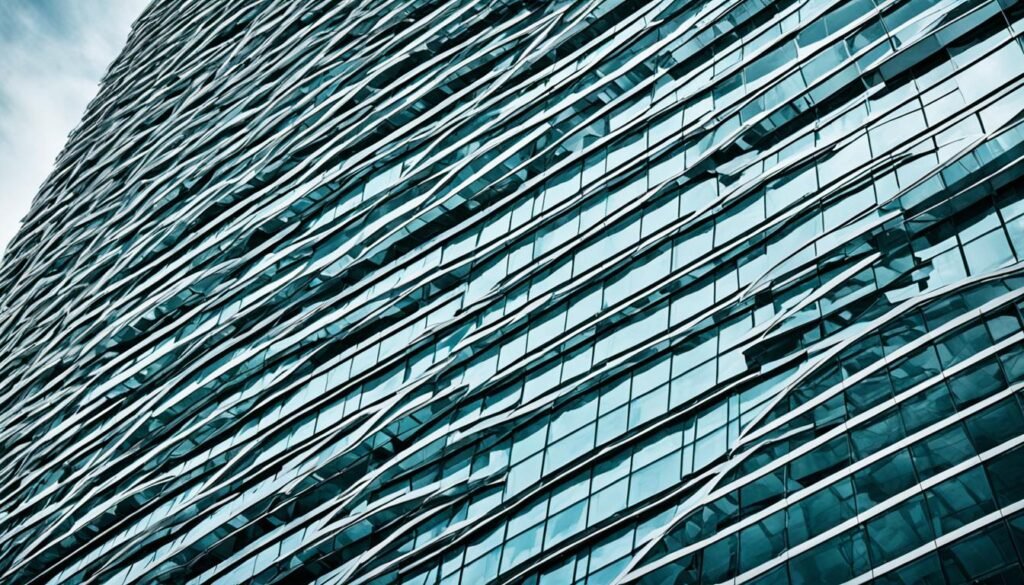
In architectural photography, the styling of the space plays a crucial role in creating visually captivating images that resonate with the intended audience. By focusing on realistic styling, photographers can elevate the photographs to convey a sense of warmth and life, adding depth and authenticity to the captured space.
One way to bring a sense of warmth and life to architectural photography is by incorporating human subjects. By including people in the frame, photographers can create a human perspective and establish a connection between the viewer and the space. Whether it’s a person enjoying a cup of coffee in a cozy kitchen or a family gathering in a living room, these human elements help tell a story and add a relatable touch.
“Realistic styling enables photographers to emphasize certain elements or focal points, creating visual depth and interest.”
Emphasis is another important aspect of architectural photography. By highlighting specific elements or focal points within the frame, photographers can draw the viewer’s attention and create a more engaging composition. Whether it’s an architectural detail, a unique feature, or a well-designed object, emphasis adds visual interest and guides the viewer through the image.
To achieve a balanced and visually pleasing composition, it is essential to carefully arrange and position objects, buildings, or scenery within the frame. This balanced arrangement ensures that the elements in the photograph complement each other harmoniously, creating a visually appealing composition that captivates the viewer.
Overall, realistic styling and emphasis are crucial in architectural photography. They bring warmth, life, and a human perspective to the images, creating a stronger connection with the audience. By arranging objects in a balanced and visually pleasing manner and emphasizing specific elements, photographers can create visually striking architectural photographs that capture the essence and beauty of the space.
The Importance of Realistic Styling and Emphasis
| Benefits | Description |
|---|---|
| Enhances realism | The use of realistic styling adds authenticity and a sense of life to the photographs. |
| Creates a human connection | Incorporating human subjects helps establish a relatable perspective and emotional connection. |
| Emphasizes focal points | By highlighting specific elements, photographers direct the viewer’s attention and add visual interest. |
| Creates visual balance | A balanced arrangement of objects and elements within the frame ensures a visually pleasing composition. |
The Role of Skilled Post-Production and Editing in Architectural Photography
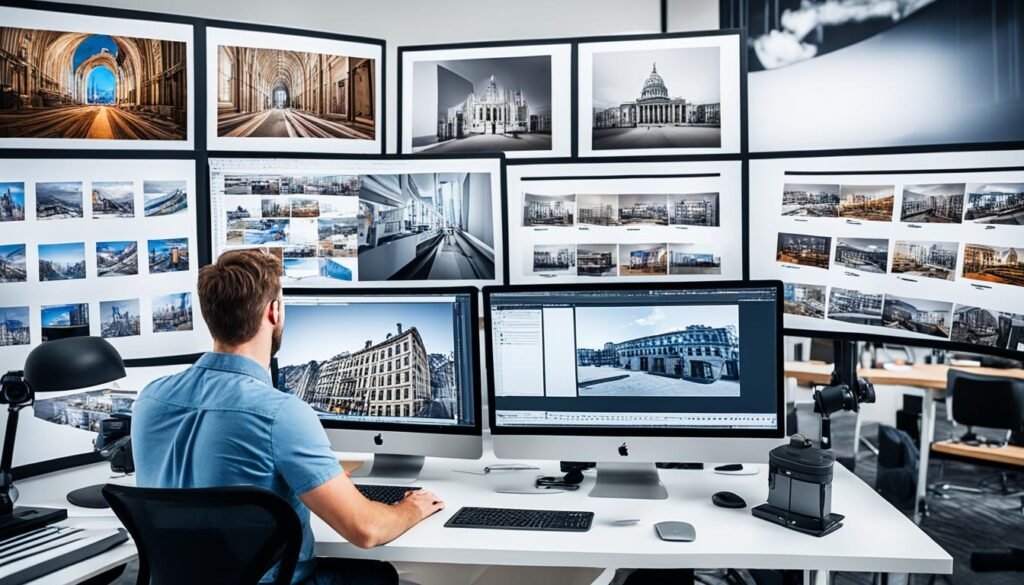
In architectural photography, the role of skilled post-production and editing should not be underestimated. While it is crucial to maintain realism, post-processing techniques can enhance the final photographs, bringing out the details and making the colors pop.
One of the key aspects of post-production is adjusting the white balance. This process ensures that the colors in the image appear natural and accurate. By fine-tuning the white balance, photographers can correct any color casts caused by the lighting conditions during the shoot.
Contrast is another important element that can be enhanced through editing. Increasing the contrast brings out the differences between light and dark areas in the photograph, resulting in a more visually striking image. It helps to define the architectural features and create depth.
Saturation is also a crucial factor to consider. Increasing the saturation makes the colors appear richer and more vibrant, bringing the image to life. However, it is crucial to use saturation adjustments sparingly, ensuring that the final result remains realistic and doesn’t detract from the architecture’s essence.
Sharpening is an essential step in post-production. It enhances the clarity and sharpness of the photograph, making the details stand out. By sharpening the image, photographers can bring out the textures and intricate elements of the architecture, capturing the viewer’s attention.
Throughout the post-processing and editing process, it is essential to maintain realism and authenticity. While enhancing certain aspects, it is crucial not to overdo the edits, as this can result in unrealistic and distorted images. Skilled photographers know how to strike the right balance, ensuring that the final photographs maintain their sense of reality and capture the true essence of the architecture.
The post-processing and editing phase allows photographers to refine their work and ensure that the photographs are of high quality and visually appealing. It is an opportunity to polish the images, fine-tuning the elements to create a visually stunning result. By utilizing post-production techniques effectively, photographers can elevate their architectural photographs and showcase the true beauty of the structures they capture.
Skilled post-production and editing play a vital role in enhancing the final photographs of architectural photography. Through adjustments in white balance, contrast, saturation, and sharpening, photographers can bring out the best in their images while maintaining realism and authenticity. The post-processing phase allows for refinement and fine-tuning, ensuring that the photographs represent the architecture’s true essence. By utilizing these techniques effectively, photographers can create visually striking and captivating images that leave a lasting impact.
The Impact of Lens Choice and Movement in Architectural Photography
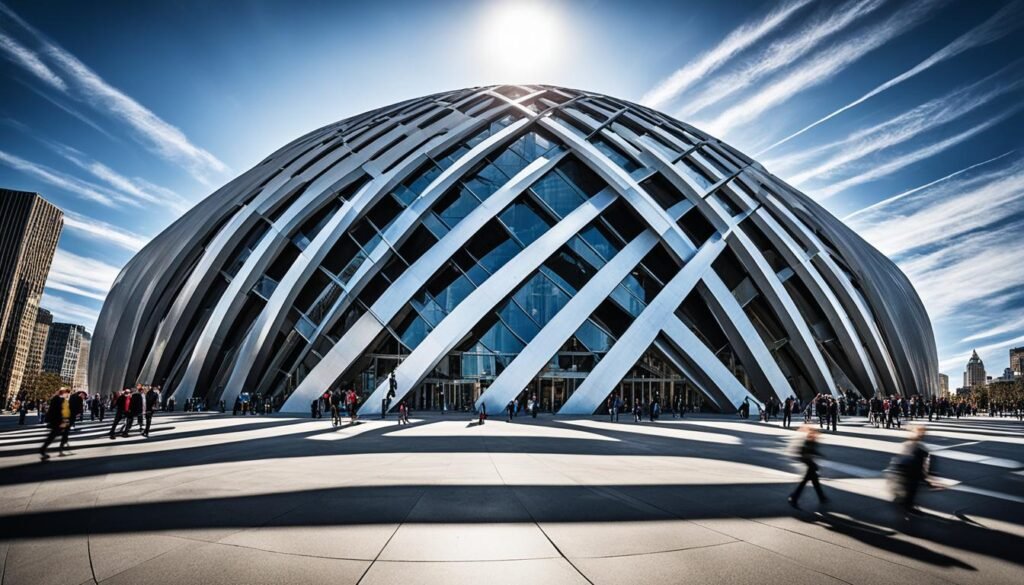
In the realm of architectural photography, the choice of lens holds immense significance in shaping the final outcome. Whether you opt for a wide-angle lens or a tilt-shift lens, your decision will impact how buildings and their intricate details are captured and depicted.
Wide-angle lenses are frequently favored for architectural photography as they allow for capturing expansive views and encompassing the grandeur of a structure in a single frame. These lenses excel at presenting a comprehensive portrayal of the building and its surroundings.
On the other hand, tilt-shift lenses give photographers the ability to correct perspective distortion and ensure straight vertical lines. This type of lens ensures a more accurate representation of the building’s features, making it a valuable tool for architectural photographers seeking precision and exactness.
However, lens choice is not solely limited to these two options. Longer lenses can also be used to create dynamic shots that compress perspective, resulting in visually compelling images. By opting for a longer lens, photographers can emphasize specific elements of a building, drawing attention to intricate details and unique features.
Injecting movement into architectural photographs can add a sense of time and dynamism to an otherwise static scene. A simple act like capturing a person walking or the wind gently blowing through the frame can bring the photograph to life and evoke a feeling of being present in that specific moment. The resulting images have added depth and atmosphere, elevating them beyond mere snapshots and transforming them into captivating visual narratives.
Incorporating movement is further enhanced by utilizing a slow shutter speed. By intentionally blurring the movement, photographers can achieve a more artistic and expressive effect. This technique immerses the viewer in a scene where time seems to slow down, creating a heightened sense of presence and a deeper connection with the photograph.
Also Read: Explore Top Architecture Courses Online And On-campus
Conclusion
Architectural photography is a unique genre that combines technical skills with artistic vision to create visually striking images. The importance of lighting, composition, subject selection, and post-processing cannot be overstated in capturing the essence and beauty of architectural structures.
Lighting plays a crucial role in architectural photography by adding depth and enhancing the features of the building. Composition guides the viewer’s eye and creates a visual balance, while subject selection helps tell a compelling story. Post-processing techniques, when applied skilfully, can enhance the image without compromising its realism.
In addition, architectural photography goes beyond mere documentation; it is a means of storytelling and showcasing the photographer’s personal style. By combining technical expertise with creative flair, photographers can create images that leave a lasting impact and effectively convey the purpose, function, and emotion of the architecture.
In conclusion, architectural photography is a fascinating and challenging genre that requires a keen eye, technical proficiency, and a touch of artistry. By understanding the importance of lighting, composition, subject selection, post-processing techniques, and the art of storytelling, photographers can capture the timeless beauty of architectural structures in a way that not only pleases the eye but also resonates with the viewer.
FAQs
Q: What is architectural photography?
A: Architectural photography is a genre of photography that focuses on capturing images of buildings, structures, and spaces, highlighting their design, details, and aesthetic appeal.
Q: Why is architectural photography unique?
A: Architectural photography is unique because it combines elements of art, design, and photography to showcase the beauty and functionality of architectural structures.
Q: What equipment is typically used in architectural photography?
A: Architectural photographers often use DSLR cameras, wide-angle lenses, tripod stands, and perspective control tools to capture high-quality images of buildings and interiors.
Q: How does architectural photography differ from other types of photography?
A: Architectural photography focuses specifically on buildings and structures, emphasizing their design, scale, and visual impact, while other types of photography may concentrate on different subjects or themes.
Q: What is the purpose of architectural photography?
A: The purpose of architectural photography is to document and showcase the design, aesthetics, and craftsmanship of architectural projects, as well as to inspire and educate viewers about the world of architecture.
Q: How can architectural photography skills be improved?
A: Improving architectural photography skills involves mastering composition techniques, understanding lighting conditions, experimenting with perspectives, and continuously practicing and refining your craft.
Q: What are some tips for interior architectural photography?
A: When capturing interior spaces, focus on composition, lighting, and angles to highlight the unique features and ambiance of the architecture. Use a wide-angle lens to capture the full scope of the room and pay attention to details that make the space visually appealing.
